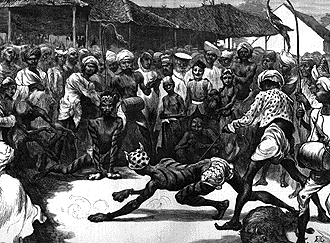| HUMAN TIGERS |
| "This is a common scene in the bazaars and around the lines of British Sepoy regiments in any station in India ruing the Mohammedan festival of Mohurrum. This festival is of a religious nature, celebrating the martyrdom of HASAN and HUSSAIN, sons of ALI, cousin and pupil of MOHAMMED, who is recognized by one sect of Mohammedans - viz. the "Shias" - as a prophet equal to Mohammed himself. The veneration by this sect for ALI and his descendants brings them into collision with the more orthodoz sect of the "Sonnis," who recognize no prophet to be equal to MOHAMMED; and on this day the enthusiasm of the opposite parties often leads to the most violent demonstrations of religious zeal. Nowadays the festival, so far from being peculiar to one sect of Mohammedans, is celebrated by all the lower classes of natives, of whatever creed, Hindoos being perfectly willing to shout "HASAN!" "HUSSAIN!" so long as it gives them an excuse for a holiday. |
| "'The tiger has no connection with the religious proceedings of the day. The animal, being the great terror of the country, was probably introduced into the general mummery just as any popular bogie might be into any carnival in the world. |
| "The Sepoys from Oude and Hindoostan proper make the best tigers, their small waists and supple bodies enabling them the better to imitate the stealthy action of the beast; but, besides natural advantages, some practice is necessary before a man can appear with success in the part. When really proficient, the action of the man-tiger is as perfect as possible, considering how extremely unlike the animal the human form is in its natural state. The dress, or rather undress, necessary for the part is a skull-cap with ears affized, a pair of gloves in the likeness of the animal's paws, a tall nodding tufted tail, short tight-fitting drawers, and paint applied over all from head to foot, at the discretion of the performer. The tiger is attended by two or three keepers, one of whom holds him by a chain round the waist, one supports his tail, and a third perhaps carries a "dummy sheep," to be used as prey. |
| "A drum (without which no native performance would be complete) is hired from the bazaar, and a few friends join in to encourage the others. The party remains out all day, which must be tiring work for the principal, who has to keep his muscles working the whole time, being always in a crouching position - partly on all fours and partly supporting himself by the muscles of the thighs. Every now and then he has to go through the performance of killing the dummy sheep, which, with the heat, dust and incidental roaring, is no joke. There is always great rivalry between the parties. In the sketch,two tigers have met face to face, and a feline row is imminent. The cat-like posture and action of the two players is very striking.' |

